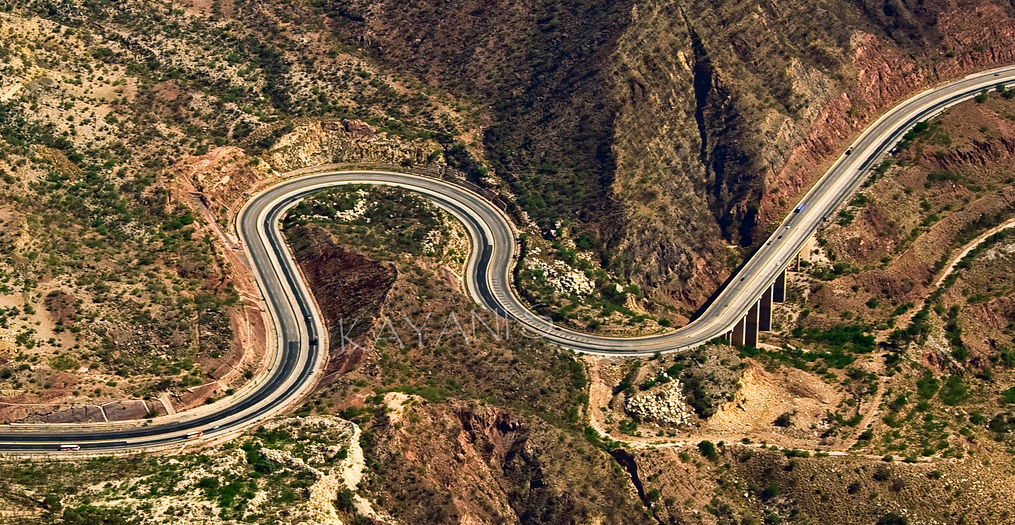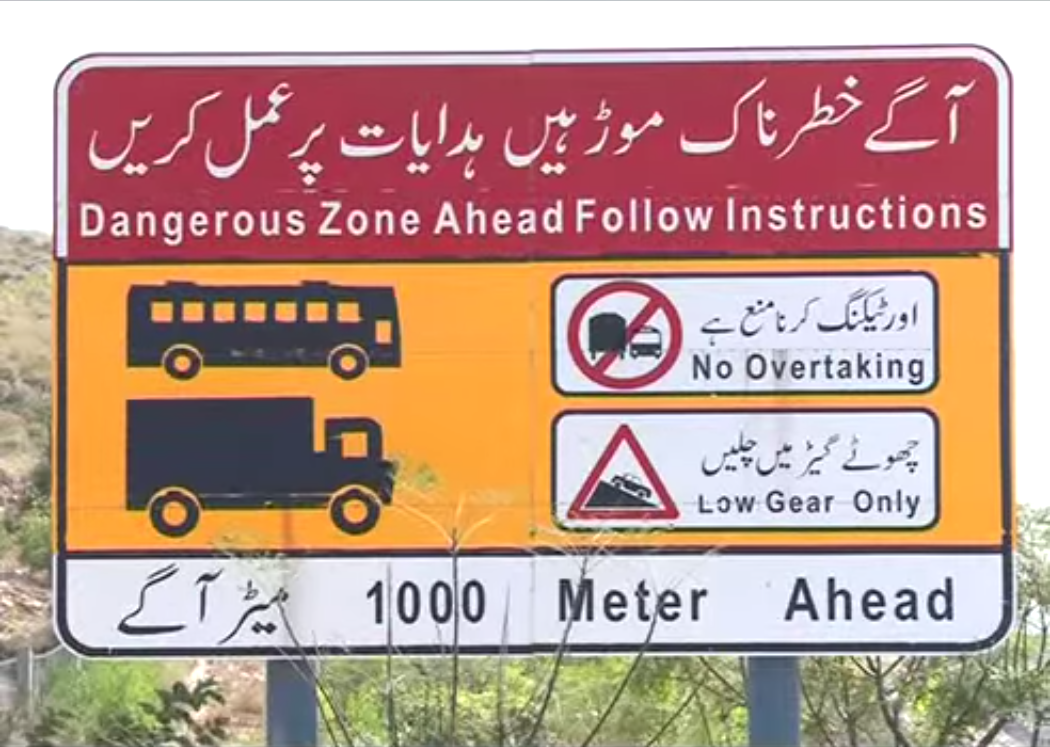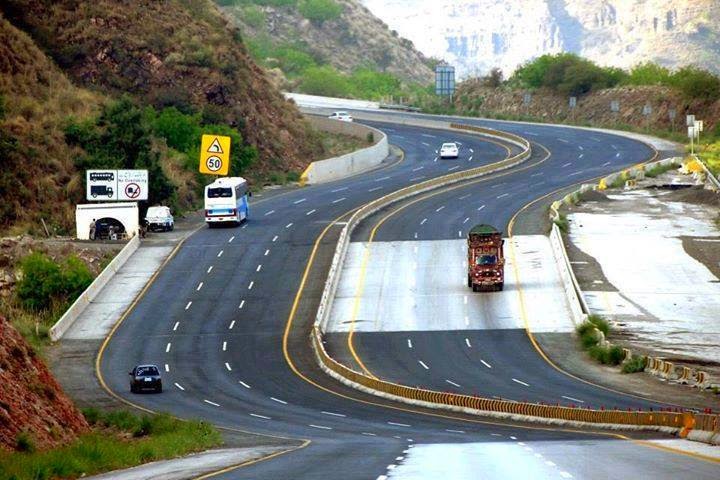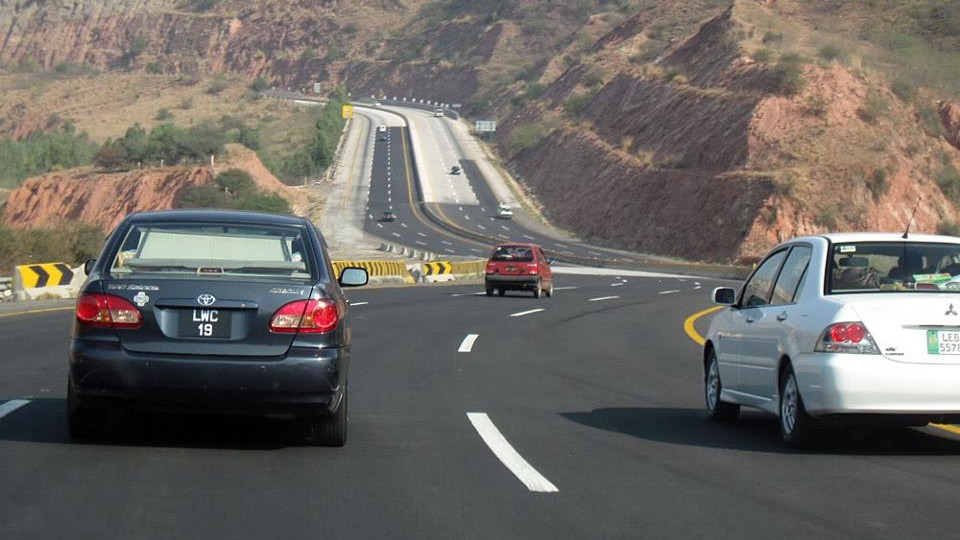Commuters, who travel a lot on M2 Motorway (Isb-Lhr), would know the perils of driving through the Salt Range next to Kallar Kahar. You might have seen that video were a courageous man tried to stop a trailer on the loose when its brakes failed and the driver bailed out. That incident also took place in the Salt Range.
The motorway patch that goes through Salt Range is of around 10 kilometers and has 7% downward slope. It is considered to be one of the most dangerous patches of tarmac on the entire motorway. Unfortunately, this patch of motorways has claimed hundreds of precious lives, including that awful incident when brakes of a school bus failed and 40 children passed away.
This particular area starts after the Kallar Kahar interchange, when you are going towards Lahore from Islamabad. Since the inauguration of the motorway in 1997, according to Motorway Police, there have been more than 350 accidents on the motorway in Salt Range and claimed more than 200 lives. Since it is continuous downward slope, if your vehicle has even the slightest of weakness, or you were not careful enough, the things can get out of hands. And it is not just about the slope, add dangerous corners to the mix and you have a deadly combination.
People unfortunately rely way too much on their luck and disregard the simple rules of physics. They think they and their vehicles can trump the deadly combo of constant slope and dangerous turns but when their vehicles fail on them, the whole situation snowballs into something far more catastrophic, like loss of innocent lives.
M2 (South) Point 231 is the start of the road where the slope starts. You will start to notice a bunch of caution and danger boards, warning you to test your brakes and start slowing your car to certain speeds. You are asked to put your vehicle in lower gear to engage engine braking and if you have a vehicle with higher center of gravity, like a coach or a bus, be very careful with the sudden steering movement that can make the vehicle tumble. It is mandatory for heavy traffic to stop at the side and allow their brakes to cool down before continue traveling. Also there is a threat of falling rocks and there are a plenty of warning signs informing you about them. Each turn has a traffic sign with allowed speed limit and to what direction is the turn.
A harrowing statistic about the accidents in Salt Range is that 90% accidents were caused by brake failures. M2 (South) Point 229 is the point where on 26 September, 2011, a school bus crashed, also due to brake failure, and we lost 40 innocent children. Point 229 is considered to be the most deadly where majority of the accidents happen. Estimated 200 accidents have happened at Point 229, and many of them caused fatalities.
 Other than Point 229, there are points 224 and 230 as all that are considered high risk areas of the motorway. If you are also faced with such situation, where brakes of your vehicle have started to fade or completely fail, you must first stop yourself from panicking, and start to scrap your vehicle with the side or center medians throughout the road, to slow the car down. And when you see the emergency climb, safely position your car towards it so it can climb the upward slope and eventually slow down to halt. One astonishing fact about the Salt Range is that throughout its 10 kilometer run, there are only three emergency climbs. There is an urgent need to increase the safe zones throughout the Salt Range.
Other than Point 229, there are points 224 and 230 as all that are considered high risk areas of the motorway. If you are also faced with such situation, where brakes of your vehicle have started to fade or completely fail, you must first stop yourself from panicking, and start to scrap your vehicle with the side or center medians throughout the road, to slow the car down. And when you see the emergency climb, safely position your car towards it so it can climb the upward slope and eventually slow down to halt. One astonishing fact about the Salt Range is that throughout its 10 kilometer run, there are only three emergency climbs. There is an urgent need to increase the safe zones throughout the Salt Range.
The M2 (South) Point 231 to Point 222 is called as the ‘red zone of motorway’. You following the prescribed brake testing and driving procedures ensures the safety of you and your passengers and also reduces the human error.
In 2005, the government of that time had plans to bypass the Salt Range and lay out a safer route for the motorway travelers. But unfortunately the plan got lost in the mix of red tape and political uncertainty. However, in 2006, the Salt Range patch was upgraded because of the threat it was causing. Bigger and brighter warning signs were placed and road markings were improved for easy visibility.
There are always some precautions you can take. First and foremost, refrain from speeding at all costs. Do not try to overtake unnecessarily in Salt Range area. Make sure your brakes and tires are in good condition to travel at high speeds for a long period of time and can take some serious high speed beating. At the start of the Salt Range, you will notice a warning sign prompting you to test your brakes before the slope starts. Keep a look behind for the oncoming traffic and press your brake relatively harder to make sure it is biting. Do not drive if you are feeling sleepy or dizzy, and that caution goes out to your general motorway travel precautions as well. If you are driving a heavy vehicle, make sure you are extra careful and keep the speeds under control. It is always better to be safe than sorry. Happy motoring.






There should have been actual tips about how to actually drive on slopes.
Like drive on low gear to use engine brake to keep the speed slow.
Or that you should not use continuous brakes on downward slope because they will heat up and fail.
and stuff like that.
It is surprising that in spite of all the warnings, accidents are still taking place
Overconfidence is a major factor here; as usual the nature of people when they will see M.police they will take care otherwise……………………………
Very foolish thinking
Most people driving automatics have no clue that the gear positions called “L”, “B” or “2” are for these situations. Especially doing down-hill, selecting a lower gear can help keep control of the car through engine braking as well.
A important point or crux problem at Salt Range is completely missed in this review as explained below:
1. The problem is not 7% longitudinal slope (downward or upward slope). This rate of slope, although is acceptable in highway design, but undesirable in Motorway. It is due to the fact that at such slope car will not be able to maintain its design speed limit, which is 120 km/h in case of M2.
2. Crux of problem is super-elevation. It is given on turns where outward side of road is raised and inward side of road is lowered to enhance centripetal force on vehicle to facilitate turning at high speeds.
3. In Salt Range, super-elevation is in reverse i.e. inward side is raised while outward side is at lower level. This design concept is not comprehensible to my knowledge. Any expert designer can enlighten us which will be welcomed.
4. This flawed design in Salt Range results in vehicles losing control at high speed and/or increased frequency of hard braking which over-heats brake pads causing it to fail.
5. In some vehicle the failure may be temporary till brakes cool down while in other the brake pads/ discs fail permanently.
Therefore, it is highly recommended that you should always put genuine brakes in your vehicle not third party brands such as MK, FK, Taiwan, Malaysia etc etc as these are more susceptible to getting over-heat. Secondly, observe the speed limit on salt range which is 60 to 80 km/h.